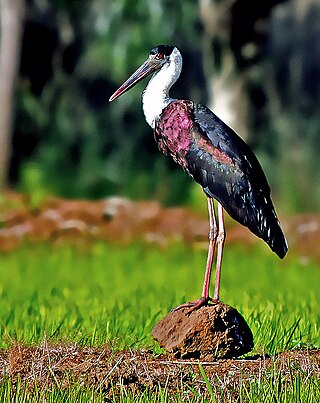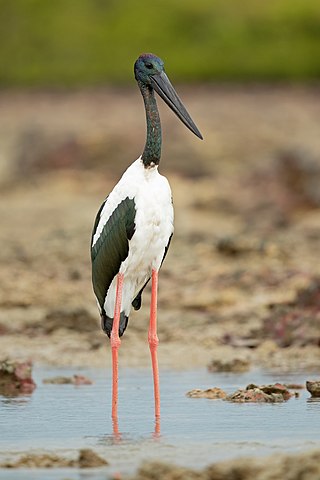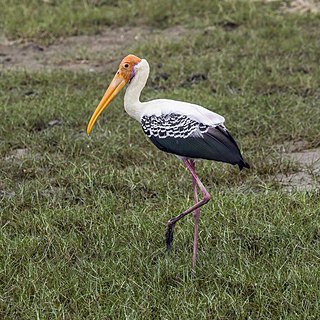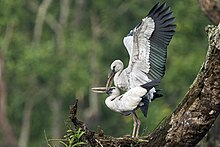
Storks are large, long-legged, long-necked wading birds with long, stout bills. They belong to the family called Ciconiidae, and make up the order Ciconiiformes. Ciconiiformes previously included a number of other families, such as herons and ibises, but those families have been moved to other orders.

The glossy ibis is a water bird in the order Pelecaniformes and the ibis and spoonbill family Threskiornithidae. The scientific name derives from Ancient Greek plegados and Latin, falcis, both meaning "sickle" and referring to the distinctive shape of the bill.

Herons are long-legged, long-necked, freshwater and coastal birds in the family Ardeidae, with 72 recognised species, some of which are referred to as egrets or bitterns rather than herons. Members of the genera Botaurus and Ixobrychus are referred to as bitterns, and, together with the zigzag heron, or zigzag bittern, in the monotypic genus Zebrilus, form a monophyletic group within the Ardeidae. Egrets do not form a biologically distinct group from herons, and tend to be named differently because they are mainly white or have decorative plumes in breeding plumage. Herons, by evolutionary adaptation, have long beaks.

The Asian woolly-necked stork or Asian woollyneck is a species of large wading bird in the stork family Ciconiidae. It breeds singly, or in small loose colonies. It is distributed in a wide variety of habitats including marshes in forests, agricultural areas, and freshwater wetlands across Asia.

The lesser adjutant is a large wading bird in the stork family Ciconiidae. Like other members of its genus, it has a bare neck and head. It is however more closely associated with wetland habitats where it is solitary and is less likely to scavenge than the related greater adjutant. It is a widespread species found from India through Southeast Asia to Java.

The black-necked stork is a tall long-necked wading bird in the stork family. It is a resident species across the Indian Subcontinent and Southeast Asia with a disjunct population in Australia. It lives in wetland habitats and near fields of certain crops such as rice and wheat where it forages for a wide range of animal prey. Adult birds of both sexes have a heavy bill and are patterned in white and irridescent blacks, but the sexes differ in the colour of the iris with females sporting yellow irises and males having dark-coloured irises. In Australia, it is known as a jabiru although that name refers to a stork species found in the Americas. It is one of the few storks that are strongly territorial when feeding and breeding.

The spot-billed pelican or gray pelican is a member of the pelican family. It breeds in southern Asia from southern Iran across India east to Indonesia. It is a bird of large inland and coastal waters, especially large lakes. At a distance they are difficult to differentiate from other pelicans in the region although it is smaller but at close range the spots on the upper mandible, the lack of bright colours and the greyer plumage are distinctive. In some areas these birds nest in large colonies close to human habitations.

The little cormorant is a member of the cormorant family of seabirds. Slightly smaller than the Indian cormorant it lacks a peaked head and has a shorter beak. It is widely distributed across the Indian Subcontinent and extends east to Java, where it is sometimes called the Javanese cormorant. It forages singly or sometimes in loose groups in lowland freshwater bodies, including small ponds, large lakes, streams and sometimes coastal estuaries. Like other cormorants, it is often found perched on a waterside rock with its wings spread out after coming out of the water. The entire body is black in the breeding season but the plumage is brownish, and the throat has a small whitish patch in the non-breeding season. These birds breed gregariously in trees, often joining other waterbirds at heronries.

The painted stork is a large wader in the stork family. It is found in the wetlands of the plains of tropical Asia south of the Himalayas in the Indian Subcontinent and extending into Southeast Asia. Their distinctive pink tertial feathers of the adults give them their name. They forage in flocks in shallow waters along rivers or lakes. They immerse their half open beaks in water and sweep them from side to side and snap up their prey of small fish that are sensed by touch. As they wade along they also stir the water with their feet to flush hiding fish. They nest colonially in trees, often along with other waterbirds. The only sounds they produce are weak moans or bill clattering at the nest. They are not migratory and only make short-distance movements in some parts of their range in response to changes in weather or food availability or for breeding. Like other storks, they are often seen soaring on thermals.

The wood stork is a large American wading bird in the family Ciconiidae (storks), the only member of the family to breed in North America. It was formerly called the "wood ibis", although it is not an ibis. It is found in subtropical and tropical habitats in the Americas, including the Caribbean. In South America, it is resident, but in North America, it may disperse as far as Florida. Originally described by Carl Linnaeus in 1758, this stork likely evolved in tropical regions. The head and neck are bare of feathers, and dark grey in colour. The plumage is mostly white, with the exception of the tail and some of the wing feathers, which are black with a greenish-purplish sheen. The juvenile differs from the adult, with the former having a feathered head and a yellow bill, compared to the black adult bill. There is very little sexual dimorphism.

The black-headed ibis, also known as the Oriental white ibis, Indian white ibis, and black-necked ibis, is a species of wading bird of the ibis family Threskiornithidae which breeds in the South and Southeast Asia from India to the west and as far east as Japan. It is the only native ibis species in its range that has an overall white plumage with a black neck and head. The down-curved beak and legs are also black. Though often referred to as a wetland species, the black-headed ibis forages in a range of natural and man-made habitats. This species of ibis nests only during the rainy season.

The openbill storks or openbills are two species of stork in the genus Anastomus. They are large wading birds characterized by large bills, the mandibles of which do not meet except at the tip. This feature develops only in the adults. Both species feed predominantly on molluscs. The roof of the upper bill is fringed with plate-like structures ("lamellae") in the African openbill, but these are absent in the Asian openbill.

The milky stork is a stork species found predominantly in coastal mangroves around parts of Southeast Asia. It is native to parts of Cambodia, Vietnam, Malaysia and Indonesia. They were once part of the genus Ibis, but is currently included in the genus Mycteria, due to similarities with other storks in that genus.

The red-naped ibis also known as the Indian black ibis or black ibis is a species of ibis found in the plains of the Indian Subcontinent. Unlike other ibises in the region it is not very dependent on water and is often found in dry fields a good distance away from water. It is usually seen in loose groups and can be told by the nearly all dark body with a white patch on the shoulder and a bare dark head with a patch of crimson red warty skin on the crown and nape. It has a loud call and is noisy when breeding. It builds its nest most often on the top of a large tree or palm.

Storm's stork is a medium-sized stork species that occurs primarily in lowland tropical forests of Indonesia, Malaysia and southern Thailand. It is considered to be the rarest of all storks, and is estimated to number less than 500 wild individuals throughout its geographic range. The population has long been in decline and the primary cause is widely considered to be deforestation of its native habitat.

The African openbill is a species of stork from the family Ciconiidae. It is widely distributed in Sub-Saharan Africa and western regions of Madagascar. This species is considered common to locally abundant across its range, although it has a patchy distribution. Some experts consider there to be two sub-species, A. l. lamelligerus distributed on the continent and A. l. madagascariensis living on the island of Madagascar. Scientists distinguish between the two sub-species due to the more pronounced longitudinal ridges on the bills of adult A. l. madagascariensis. The Asian openbill found in Asia is the African openbill’s closest relative. The two species share the same notably large bill of a peculiar shape that gives them their name.

The dusky eagle-owl is an owl species in the family Strigidae that is widespread in South and Southeast Asia. The type specimen used to describe the species was collected on the Coromandel Coast, which was used for the specific epithet. It is listed as Least Concern on the IUCN Red List. The species's extent of occurrence is estimated at 9,250,000 km2 (3,570,000 sq mi). However, volunteer generated databases such as eBird.org suggest that the available extent of occurrence is a vast over-estimate.

Vedanthangal Bird Sanctuary is a 30-hectare (74-acre) protected area located in the Madurantakam taluk of the Chengalpattu District in the state of Tamil Nadu, India. The sanctuary is about 75 kilometres (47 mi) from Chennai on National Highway 45 ([NH45]). It is easily reachable from Madurantakam and Chengalpattu. More than 40,000 birds, from various parts of the world visit the sanctuary during the migratory season every year. Vedanthangal is home to migratory birds such as pintail, garganey, grey wagtail, blue-winged teal, common sandpiper and the like. It has been designated as a protected Ramsar site since 2022.

The sarus crane is a large nonmigratory crane found in parts of the Indian subcontinent, Southeast Asia, and Australia. The tallest of the flying birds, standing at a height of up to 1.8 m, they are a conspicuous species of open wetlands in South Asia, seasonally flooded Dipterocarpus forests in Southeast Asia, and Eucalyptus-dominated woodlands and grasslands in Australia.

The African woolly-necked stork or African woollyneck is a species of large wading bird in the stork family Ciconiidae. It breeds singly, or in small loose colonies. It is distributed in a wide variety of habitats including marshes in forests, agricultural areas, and freshwater wetlands across Africa.




























